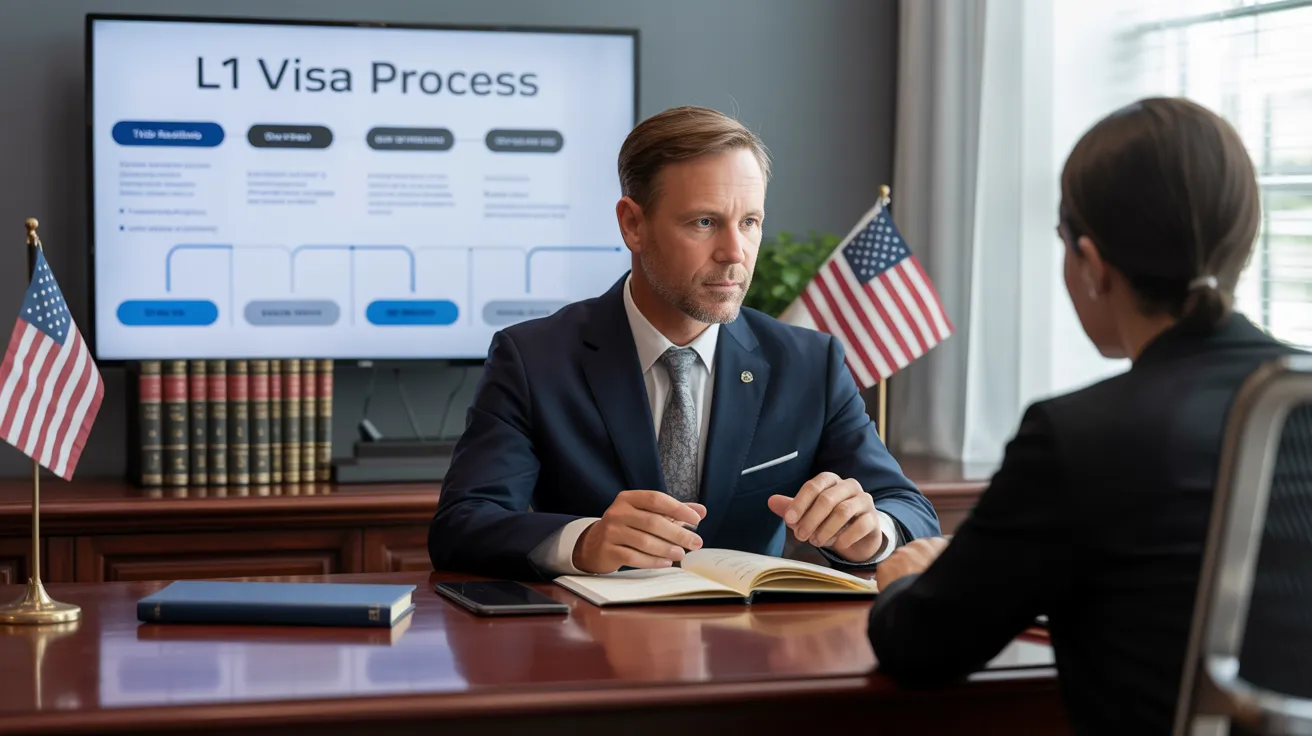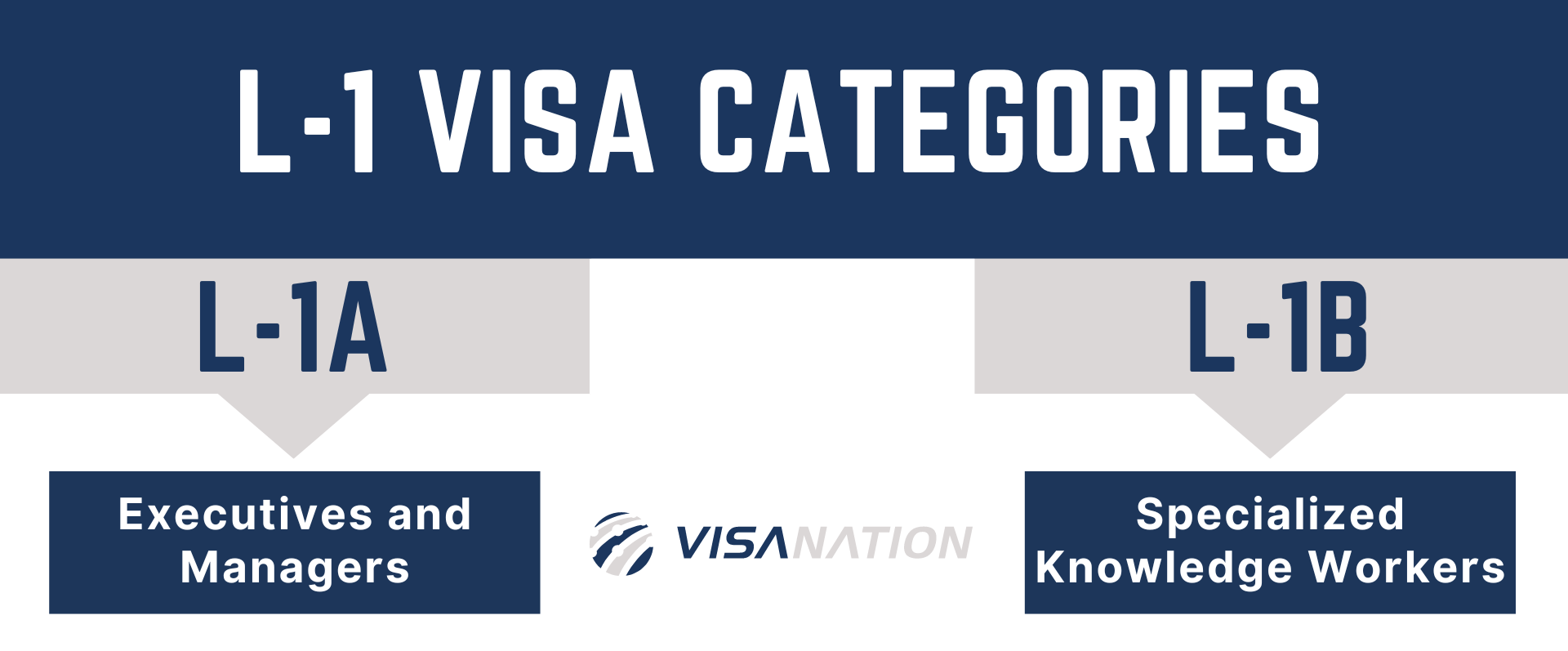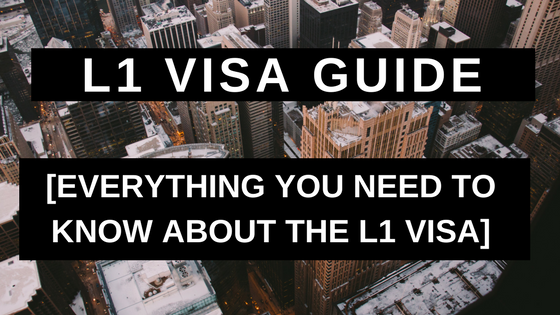Unlocking Opportunities: A Comprehensive Guide to the L1 Visa Process
The L1 visa procedure offers a critical pathway for multinational business seeking to move essential employees throughout boundaries. Recognizing the nuances of eligibility standards, the differences in between L-1A and L-1B visas, and the complexities of the application process can significantly impact a candidate's success. However, maneuvering this complex landscape is not without its difficulties, and cautious interest to documents and company sponsorship is essential. As we discover the key parts of this procedure, the strategies for getting rid of potential obstacles will become obvious, revealing exactly how informed preparation can open up a globe of chances.
Comprehending the L1 Visa
Comprehending the L1 visa requires acknowledging its importance as an essential tool for international firms seeking to transfer proficient workers between global workplaces. This non-immigrant visa group facilitates the movement of executives, supervisors, and specialized expertise workers to the USA, therefore making it possible for companies to keep operational connection and harness global talent efficiently. The L1 visa is divided right into 2 main categories: L-1A for supervisors and execs, and L-1B for staff members having specialized knowledge.The L1 visa serves a crucial duty in improving a business's affordable edge in the global market. By permitting business to move their vital workers, organizations can ensure that crucial tasks are taken care of by qualified individuals that are currently acquainted with the business's society and functional procedures. L1 Visa. This interior transfer mechanism not just promotes knowledge sharing but additionally advertises innovation and partnership across borders.Moreover, the L1 visa is often favored for its relatively simple application process contrasted to various other visa classifications, as it enables dual intent, permitting holders to go after irreversible residency while on a momentary job visa. This feature makes the L1 visa especially appealing for both employers and workers, as it streamlines the path for competent specialists to establish long-lasting residency in the United States
Qualification Criteria
Qualification for the L1 visa pivots on several essential standards that ensure both the staff member and the company satisfy specific credentials. This non-immigrant visa is designed for international firms to move workers from international offices to united state counterparts.Firstly, the employer should be a qualifying company, that includes a moms and dad business, branch, affiliate, or subsidiary of a united state company. The firm needs to have been doing business for a minimum of one year both in the U.S. and abroad. This guarantees that the firm has enough operational stability and a legit presence.Secondly, the worker has to hold a supervisory, exec, or specialized knowledge position. For L1A visas, the candidate should demonstrate managerial or executive credentials, while L1B visas concentrate on specialized understanding relevant to the company's items, services, or processes. In addition, the employee has to have worked for the foreign entity for at the very least one continuous year within the last 3 years prior to their application.Lastly, the worker's role in the U.S. have to straighten with their previous position, guaranteeing that their skills and competence are leveraged for the business's benefit.

Kinds Of L1 Visas
The L1 visa classification consists of two main types designed to help with the transfer of staff members within international business: the L1A visa for managers and execs, and the L1B visa for employees with specialized expertise. Each type offers unique purposes and has details eligibility criteria.The L1A visa is customized for people who hold supervisory or executive settings within a business. This visa enables top-level employees to transfer to an U.S. branch, subsidiary, or affiliate of the very same organization. Candidates for the L1A visa must show that they have been employed in a managerial or executive capacity for at the very least one continuous year within the past 3 years before their application. Furthermore, this visa uses a longer period of keep, originally provided for three years, with the opportunity of expansions for approximately seven years.In comparison, the L1B visa is planned for professionals with specialized knowledge pertaining to the business's products, services, or processes. To qualify, applicants should verify that their experience is crucial to the company which they have actually functioned for at the very least one continual year within the last three years in a role that required this specialized knowledge. The L1B visa is at first provided for three years, with expansions readily available for up to 5 years.Both visa types are necessary for business seeking to enhance their global operations by leveraging experienced workers, therefore advertising innovation and efficiency within the U.S. market.
Application Process
Steering through the L1 copyright procedure involves numerous vital steps that should be thoroughly followed to ensure a successful result. The process begins with the U.S. employer, who should first establish qualification by showing a certifying relationship with the foreign entity and confirming that the employee fulfills the specific needs for the L1 visa category being sought.Once eligibility is verified, the employer starts the procedure by submitting Type I-129, the Application for a Nonimmigrant Employee, with the United State Citizenship and Migration Services (USCIS) This type needs to be gone along with by an in-depth summary of the task duties to be performed, the business framework of both the united state and international entities, and the staff member's certifications. It's crucial to verify that all details is exact and complete, as noninclusions or mistakes can bring about hold-ups or denials.Upon approval of the I-129 petition, the next step includes the employee making an application for the L1 visa at an U.S. embassy or consulate in their home country. This stage calls for the conclusion of Kind DS-160, the Online Nonimmigrant copyright, and setting up a meeting. Throughout the interview, the candidate has to provide evidence supporting their credentials and the employer's petition.After the visa is provided, the employee can go into the United States to work in the designated duty. Generally, careful prep work and adherence to each action of the application procedure are vital for a successful L1 visa end result.
Called for Documents

Essential Forms Required
Maneuvering the L1 Visa process requires careful focus to the crucial forms and documents needed for an effective application. The primary kind required is the Form I-129, Application for a Nonimmigrant Worker, which must be completed and submitted by the united state company (L1 Visa). This form lays out the information of the work deal and the credentials of the staff member looking for the L1 Visa.Alongside Kind I-129, the applicant will certainly require to full Type I-539 if going along with member of the family are also using for visas. Furthermore, the employer needs to offer evidence of the qualifying partnership between the united state entity and the foreign entity, often requiring the submission of company files such as posts of consolidation or financial statements.Moreover, it is vital to consist of the L Category Supplement to Kind I-129, which defines the type of L Visa being requested-- either L-1A for managers and execs or L-1B for workers with specialized knowledge. Ultimately, applicants ought to guarantee that all kinds are signed and dated suitably, as incomplete entries can bring about hold-ups or rejections. Properly assembling these important kinds lays the structure for a smoother L1 copyright procedure
Supporting Proof Requirements
Supporting documents is vital for an effective L1 Visa L1 copyright, as it substantiates the insurance claims made in the request. Candidates have to give a series of records to show qualification for the visa, which is categorized right into two key kinds: evidence of the certifying relationship between the united state and foreign entities and proof of the candidate's qualifications.To establish the relationship, applicants need to send paperwork such as business business graphes, economic statements, and proof of possession. These files confirm that the foreign company has a qualifying relationship with the U.S. employer, whether as a moms and dad firm, subsidiary, branch, or affiliate.For the candidate's qualifications, necessary files consist of a detailed work letter from the foreign employer, outlining the candidate's task title, tasks, and period of employment. Additionally, educational qualifications, such as degrees and diplomas, need to be given to verify the candidate's expertise in the appropriate field.
Company Sponsorship Documents
Company sponsorship papers play a crucial role in the L1 copyright process, as they verify the U.S. company's dedication to the candidate's employment in the United States. These files are essential for showing the company's qualification to sponsor the candidate for the L1 Visa.Key documents normally required include a comprehensive employment letter from the U.S. employer, which outlines the task title, duties, and the nature of the employment connection. In addition, the company should offer evidence of the business's authenticity, such as business licenses, income tax return, and business graphes, showing the relationship between the united state entity and the international company.Furthermore, evidence of the employee's certifying connection with the foreign firm is essential. This might include paperwork evidencing the worker's role in the international entity, such as pay stubs, work agreements, or efficiency evaluations.
Typical Challenges
Navigating the L1 visa process provides numerous usual obstacles that candidates ought to be mindful of (What Is L1 Visa). Trick concerns typically include stringent documentation requirements, possible hold-ups in processing times, and the necessity for strict legal compliance. Recognizing these obstacles can help applicants better prepare and minimize threats during their copyright trip
Paperwork Demands
The L1 copyright procedure commonly provides significant obstacles related to documents needs. Applicants have to supply substantial documents to establish qualification, which can cause confusion and prospective delays. Key files include proof of a qualifying relationship in between the united state and foreign employer, proof of the candidate's employment background, and comprehensive information about the work duty in the U.S.One typical obstacle is collecting enough proof to show the nature of the qualifying relationship. Firms usually struggle to present clear business charts or economic statements that highlight the connection between the entities. On top of that, making sure that letters of assistance from companies accurately show the applicant's job responsibilities and certifications is crucial, as vague descriptions can lead to denials.Another concern emerges from the need for detailed job summaries that line up with the L1 visa classifications. Candidates need to articulate not only their existing role but likewise their managerial or customized understanding obligations clearly. This requires an extensive understanding of both the candidate's position and the regulatory language used in L1 applications.
Handling Dead Time
Experiencing delays in handling times is a typical difficulty faced by L1 visa candidates, often causing stress and uncertainty. Several aspects add to these delays, including high application volumes, enhanced examination of applications, and administrative stockpiles within the united state Citizenship and Immigration Services (USCIS) Applicants might find that processing times can differ substantially depending upon the solution facility managing their application, as each facility has its own work and efficiency degrees. In addition, the complexity of the candidate's situation, such as the demand for extensive paperwork or information, can further extend wait times.In some circumstances, issues associated with the applicant's current migration status or previous visa background might also result in added hold-ups, as USCIS might require further evaluation or details. It is necessary for prospects to continue to be positive during this period, keeping open interaction with their companies and legal agents to deal with any potential worries promptly.Understanding these handling time difficulties can assist L1 visa applicants plan for possible delays and alleviate the effect on their shift and career strategies. Patience and diligence are essential virtues in navigating this detailed procedure.
Legal Compliance Issues
Many L1 visa candidates experience legal compliance concerns that can complicate their trip toward getting the visa. Understanding and sticking to the specific regulations set by the U.S. Citizenship and Migration Provider (USCIS) is vital. Usual difficulties include demonstrating the certifying partnership between the international and united state companies, as well as verifying that the candidate has the requisite specialized understanding or managerial capacity.Additionally, candidates should offer extensive paperwork detailing their job responsibilities, business structure, and monetary stability of the U.S. entity. Inadequate or incorrect documents can cause hold-ups and even denials. Employers have to additionally assure that they adhere to labor legislations, including wage and functioning problem standards, which can impact visa eligibility.Another typical issue includes maintaining conformity with the terms of the visa as soon as granted. Modifications in work standing, work duties, or business structure can necessitate changes to the visa, which if not attended to immediately can cause lawful difficulties. Consequently, staying informed regarding compliance requirements and looking for lawful advise when necessary is necessary to browse the intricacies of the L1 visa procedure efficiently.
Tips for Success
Success in the L1 copyright procedure frequently rests on thorough prep work and interest to information. To enhance your chances of authorization, begin by extensively understanding the eligibility demands for both the L1A and L1B visa classifications. Review whether your placement at the business qualifies as managerial, exec, or specialized expertise, as this categorization notably impacts your application.Next, collect substantial paperwork that substantiates your insurance claims. This consists of organizational graphes, comprehensive job descriptions, and proof of the firm's functional framework. Clear and concise evidence of the qualifying connection between the U.S. entity and the international entity is essential. Verify that all files are arranged rationally and presented in an expert manner, as this reflects your commitment and seriousness concerning the application.Engage the services of an experienced migration attorney that concentrates on L1 visas. Their competence can show important, leading you via complicated guidelines and guaranteeing that all paperwork abides by existing laws. Furthermore, prepare for the meeting by practicing solution to usual inquiries and being ready to discuss your function and payments to the company in depth.
Regularly Asked Questions
Can Family Members Members Accompany the L1 Visa Owner?
Yes, member of the family of L1 visa owners, consisting of spouses and unmarried youngsters under 21, can come with the key visa holder. They might also obtain L2 visas, which enable them to stay in the USA.
Just How Long Can I Remain On an L1 Visa?
The L1 visa allows initial remains of as much as three years, with the possibility of expansion. L1A visa owners might remain for an optimum of seven years, while L1B visa holders can stay for 5 years.
Can L1 Visa Owners Make An Application For a Permit?
Yes, L1 visa holders can request a permit. They may pursue long-term residency via employment-based classifications, typically requiring sponsorship from their company, offered they meet the needed credentials and documents requirements.
What Happens if My L1 copyright Is Denied?
If your L1 copyright is denied, you might receive a notice detailing the reasons for rejection. You can look for to appeal the decision, reapply, or check out alternate visa options based on your circumstances.
Exist Any Travel Restrictions With an L1 Visa?
An L1 visa normally enables international traveling; nonetheless, re-entry to the united state is contingent upon maintaining legitimate condition. Tourists must ensure conformity with visa conditions to prevent difficulties upon return
Conclusion
